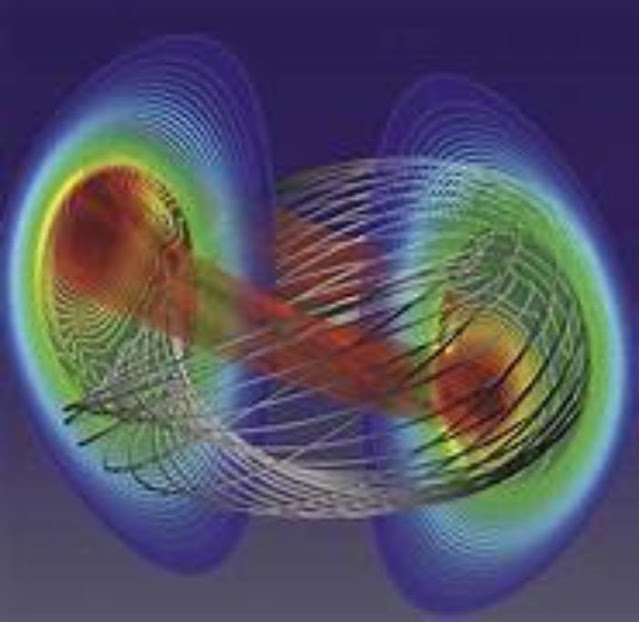Magnetic Confinement Fusion Reactors: Unlocking the Power of the Stars
The Fusion Process:
At the heart of magnetic confinement fusion lies the fusion
process itself. Fusion happens when two atomic nuclei come together to form a
heavier center, releasing a significant amount of energy in the process. In
magnetic confinement fusion reactors, the primary fuel used is a mixture of
isotopes of hydrogen, typically deuterium and tritium. These isotopes, when
brought to high temperatures and pressures, collide with enough energy to
overcome their mutual electrostatic repulsion and fuse, resulting in the issue
of energy in the form of kinetic energy and high-energy particles.
Plasma State and Confinement:
To achieve the extreme conditions necessary for fusion, a
key component is the plasma state of matter. Plasma is a high-energy, ionized
gas composed of charged particles—ions and electrons—moving freely. It's the
fourth state of matter, distinct from solid, liquid, and gas. In magnetic
confinement fusion reactors, the fuel is heated to extreme temperatures, often
exceeding millions of degrees Celsius, causing it to ionize and form a plasma.
However, plasmas are inherently challenging to confine due
to their tendency to expand and dissipate under their own pressure. To overcome
this challenge, magnetic confinement techniques are employed, where powerful
magnetic fields control and contain the plasma.
Magnetic Confinement Techniques:
Tokamak:
The tokamak is one of the most widely studied magnetic
confinement concepts. It consists of a toroidal (doughnut-shaped) chamber with
a strong magnetic field generated by a combination of external magnets and a
plasma current induced within the plasma itself. The magnetic field creates a
closed loop that confines the plasma, preventing it from coming into direct
contact with the reactor's walls.
Stellarator:
Stellarators utilize twisted and contorted magnetic fields
to confine the plasma without relying on plasma currents. This design requires
complex magnetic configurations and is more challenging to construct but offers
potential advantages in terms of steady-state operation and reduced plasma
instabilities.
Spheromak and Field-Reversed Configuration (FRC):
These concepts involve creating a self-contained plasma structure with no solid walls. They use magnetic fields to induce a closed plasma configuration that doesn't touch any physical surfaces. While challenging to stabilize, these designs have unique potential for simplicity and efficiency.
Working Principles:
In a tokamak, for instance, the magnetic fields within the
toroidal chamber create a magnetic bottle effect. The magnetic field lines
guide and constrain the plasma's movement, preventing it from escaping and
interacting with the walls. However, due to plasma's high temperature and
density, the magnetic field lines are subject to complex behavior, leading to
phenomena like plasma instabilities and turbulence. Researchers work to
stabilize and control these instabilities to maintain stable plasma conditions
for fusion to occur.
The Fusion Reaction and Energy Release:
Once the plasma reaches the required temperature and
density, fusion reactions between deuterium and tritium nuclei take place. The
most common reaction involves two isotopes of hydrogen—deuterium (D) and
tritium (T)—colliding to form a helium nucleus (He), a neutron (n), and an
immense amount of energy.
Challenges and Future Prospects:
Despite the enormous potential of magnetic confinement
fusion reactors, several challenges remain:
High Temperatures and Pressures: Achieving and maintaining
the extreme conditions necessary for fusion requires advanced materials that
can withstand high temperatures and radiation.
Plasma Stability: Controlling plasma instabilities and
turbulence is crucial for maintaining stable and efficient fusion reactions.
Sustained Fusion: Current reactors struggle to sustain
fusion for long periods, which is necessary for practical energy production.
Energy Input vs. Output: Achieving "ignition,"
where the fusion reactions produce more energy than is used to sustain them,
remains a significant technical challenge.
Materials and Radiation: The high-energy neutrons produced
during fusion reactions can damage reactor materials and induce radioactivity.
Economic Feasibility: Constructing, operating, and
maintaining fusion reactors requires significant investment, and the challenge
lies in making fusion economically competitive with other energy sources.
The Path Forward:
Despite the challenges, ongoing research and development
efforts in the field of magnetic confinement fusion are promising.
International collaborative projects, such as ITER (International Thermonuclear
Experimental Reactor), aim to demonstrate the viability of sustained fusion
reactions and pave the way for the development of practical fusion power
plants.
While a fully operational magnetic confinement fusion power plant is still on the horizon, the progress made in understanding plasma physics, magnetic confinement techniques, and materials science has brought humanity closer to the dream of harnessing the power of the stars to meet our energy needs in a clean, sustainable, and abundant manner.

.webp)
